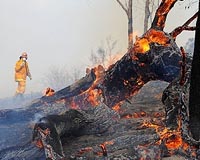| . |  |
. |
Port-Au-Prince (AFP) July 25, 2010 Julie, her face a grimace of anguish, waits with her five children for a ride to their next shelter, to where more than 1,000 homeless Haitians have been ordered to go as hurricane season ramps up. They are packed and anxious and bound for Corail, a camp 20 kilometers (12 miles) from the capital on oven-hot scrubland that the United Nations has deemed safer than areas around Port-au-Prince, where hundreds of thousands of destitute refugees live in squalor six months after an earthquake ravaged the city. The 58-year-old mother and her family have lived in wretched conditions in an impromptu shantytown on the side of a road since shortly after the earthquake rocked western Haiti, killing more than 250,000 people and injuring 300,000, leaving 1.5 million homeless and unleashing a trail of destruction. Like thousands of others, Julie clings to the hope of soon finding more permanent housing. Today she has little idea of what awaits her at the end of her ride out of town. "We were asked to leave the shelter where we had sought relief after the earthquake destroyed the house I had been renting," she says. "Now I don't even know where I will put our things." Julie and her children are among 1,200 people who are being swiftly evacuated from makeshift camps that are prone to flooding and mudslides as the Atlantic and Caribbean hurricane season -- forecast by meteorologists this year to be more active than usual -- kicks into high gear. They could be considered the luckier ones. Corail has sturdy fabric tents with waterproof tarpaulins, showers and potable water, and medical facilities. Many other makeshift camps in impoverished Haiti are in dreadful shape, and hurricanes and tropical storms here can cause calamitous damage to them. The UN has identified 130 tent cities at risk from rains and winds that could further worsen conditions for the most vulnerable internally displaced persons (IDPs), including at the Carrefour Fleuriot camp where some 200 homeless families live in sub-human circumstances. "The living conditions are unbearable here," explains Roxane, a young Frenchwoman who works with the International Organization for Migration (IOM), the agency tasked with helping Haitians made homeless by the 7.0-magnitude quake. "The water is unsafe. There are many health problems and many children are malnourished. It's impossible for people to stay here." And many are not. As families pack up, Roxane oversees the rush. "I'm careful that children are not separated from their parents, and that pregnant women and the disabled are the first to leave," she says. Having arrived in Haiti two weeks after the January 12 quake, the Paris native is committed to working with the downtrodden, but says she feels "frustration at seeing people living in such conditions." In the camp, volunteers help departing refugees bundle up their belongings -- old stoves, ripped mattresses, handfuls of utensils -- often the only tangible fragments left from their crumbled lives. "We screamed for help for a long time before being heard," said Renald, who with his wife and their two daughters is preparing to leave Carrefour Fleuriot for a tent shelter in Corail. "Here the danger was constant. We were exposed to disease, insecurity, and above all we had been forgotten by our leaders," recalls Renald, a singer-songwriter who dreams of one day recording an album. "I continued to compose songs after the quake and about 10 of them are inspired by the tragedy." Before authorities finally intervened, two quake survivors died in the chaotic camp near Port-au-Prince's airport. "Conditions could not be worse than they are in here," says Renald, who has headed the residents' committee of Carrefour Fleuriot. "People have been waiting for this opportunity" to leave, he adds. Emmanuel, 14, is more guarded about what the future holds. He is afraid of the unknown and especially does not want to leave his school. "I am willing to go, but where to?" wonders the frail boy with busy eyes. Complicating the raw emotions of heading out to a new shelter, many youths attending schools in the district will have to separate from their parents. "Corail is not the ideal solution, but the site is already set up. They will be better off there," says Roxane.
Share This Article With Planet Earth
Related Links Bringing Order To A World Of Disasters A world of storm and tempest When the Earth Quakes
 Wildfire Prevention Pays Big Dividends In Florida
Wildfire Prevention Pays Big Dividends In FloridaResearch Triangle Park NC (SPX) Jul 23, 2010 A study by USDA Forest Service Southern Research Station (SRS) scientists and research partners suggests that wildfire prevention education in Florida pays for itself several times over by saving millions of dollars in fire-fighting costs and reducing damages from human-caused fires. Researchers published their findings in a recent issue of the journal Forest Science. "This is the first st ... read more |
|
| The content herein, unless otherwise known to be public domain, are Copyright 1995-2010 - SpaceDaily. AFP and UPI Wire Stories are copyright Agence France-Presse and United Press International. ESA Portal Reports are copyright European Space Agency. All NASA sourced material is public domain. Additional copyrights may apply in whole or part to other bona fide parties. Advertising does not imply endorsement,agreement or approval of any opinions, statements or information provided by SpaceDaily on any Web page published or hosted by SpaceDaily. Privacy Statement |